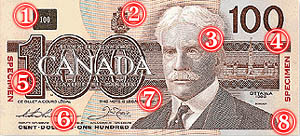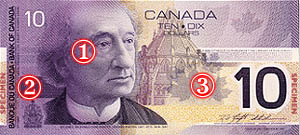|
The business community of Deer Lake were recently afforded the opportunity to attend a
seminar on counterfeit money detection. This seminar was held at the Elwood High School and was arranged by the Deer
Lake Crime Prevention Committee. The guest speaker was Mr. Allan Pacque from the Bank of Canada.
Mr. Pacque supplied visual aids and actual real and counterfeit money so that the participants could get a hands on feel and
look of the currency. The seminar proved very educational and was enjoyed by all. Mr. Pacque was presented with a certificate
of appreciation by the committee and a hearty thank you from everybody.
Cst. Desmond Burridge gave a
demonstration on counterfeit money detection prior to this and started the wheels rolling to have Mr. Pacque visit with us.
Below are some of the details to look for in detecting Counterfeit Currency.
Security features found on bank notes:
*Raised ink on the words "Bank of Canada", the
* portrait on the bill, and the Coat of Arms
*Iridescent maple leaves
* Hidden number
* Well-defined lines in the facial features of the portrait
*Micro printing
*A serial number printed twice on the back of each note.
Many stores in Canada are no longer accepting $100 bills and some are even refusing $50 bills. The stores say there are
too many counterfeit bills in circulation to risk taking the larger denominations.
The Bank of Canada says that stores can't be compelled to accept Canadian currency under federal law. While the Bank
of Canada Act gives it the sole right to print money, the Bank of Canada has no authority over how their notes are used to
settle debts, says Joe Basile of the bank's currency education team. Some provinces, however, have consumer regulations requiring
businesses to accept exact amounts of cash to settle debts. But the law is mute on providing change, for example when a consumer
offers a $50 bill for a $40 item.
The forgeries can be very accurate, the Bank of Canada admits. Store owners say that the forgeries pass the ultra-violet
(UV) light test used to find counterfeit bills.
However, the forgeries don't look completely authentic. The metallic patch in the upper-left corner, for example, may
be gold in a forged bill, while the patch on the authentic bill changes colour from gold to green when tilted.
The ink on a fake bill may run if you put water on it. As well, the detail in an authentic bill, such as the fine lines
in the eyes of the portrait, may not be duplicated perfectly in a forgery.
Security features
The current series of $100 bills have many security features designed to foil counterfeiters.
1.The metallic patch changes from green to gold when tilted. It cannot be peeled off.
2.Green dots appear randomly on each bill. They glow under UV light and can be scratched off.
3.The fine detail in the eyes and hair can't be easily duplicated.
4.The texture of the raised ink can be felt with your fingers.
5.The words "Bank of Canada" appear in microprinting in various places on the bill.
6.The special bank note paper does not glow under UV light.
7.The colours used in the bill are difficult to reproduce.
8.Each bill has a unique serial number on the reverse side. A batch of fake bills may all have the same serial number.

The latest series of bills, of which only the $5 and $10 bill have been released, use some new security features. The Bank
of Canada says new $50 and $100 bills are being released last to allow more time to develop more sophisticated anti-counterfeit
devices.
1.A glowing blue Canadian coat of arms and red security fibres appear when viewed under UV light.
2.A hidden number 10 can be seen here when the bill is viewed along its edge.
3.The golden maple leaves shimmer when the bill is tilted.



|

